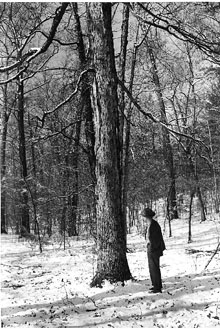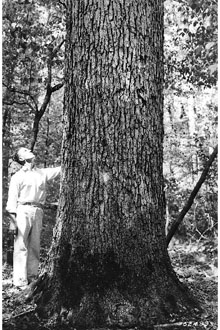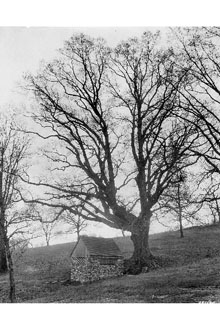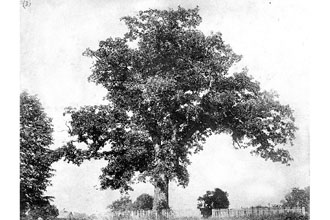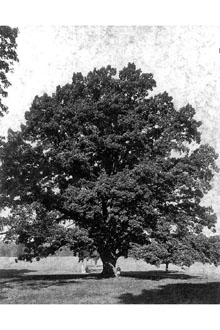White Oak
Scientific Name: Quercus alba L.

| General Information | |
|---|---|
| Usda Symbol | QUAL |
| Group | Dicot |
| Life Cycle | Perennial |
| Growth Habits | Tree |
| Native Locations | QUAL |
Plant Guide
Use soil moisture sensors to measure the soil moisture of White Oak.
Fact Sheet
Alternate Names
stave oak
Uses
Wildlife: Acorns are eaten by squirrels, blue jays, crows, red-headed woodpeckers, deer, turkey, quail, mice, chipmunks, ducks and raccoons. Timber: White oak’s wood is strong and durable for staves for barrels, lumber, flooring, and interior woodwork. Recreation and Beautification: White oak is an excellent ornamental tree because of its broad round crown, dense foliage, and purplish-red to violet-purple fall color.
Status
Please consult the PLANTS Web site and your State Department of Natural Resources for this plant’s current status (e.g. threatened or endangered species, state noxious status, and wetland indicator values).
Description
Quecus alba L., white oak, grows from Maine to Minnesota southward to Florida and Texas. It is a large, stately tree that grows up to over 100 feet tall, and 38 to 50 inches in diameter, with a round to wide spreading irregular crown. White oak bark is whitish or light gray, varying from scaly to irregularly platy or ridged and furrowed. Leaves are simple and alternately arranged on the stems; they are 5-6 inches long and have a rounded tip and wedge-shaped base, with evenly notched edges; leaves are bright green above and whitish underneath. Male flowers are green and 2-4 inches long, while female flowers are reddish and they appear as single spikes with the leaves. White oak acorns are oval; about a quarter of the acorn body is covered with a cap which drops off at maturity. There are approximately 120 seeds per pound.
Adaptation and Distribution
Distribution , Use soil moisture sensors to measure the soil moisture of White Oak.
Distribution
Although found on many soil types, white oak does best on coarse, deep, moist, well-drained, with medium fertility, and slightly acid soils. It is well adapted to heavy soils and north and east-facing slopes. Natural stands are often found in areas with loam and clay soil. White oak is moderately resistant to ice breakage, sensitive to flooding, and resistant to salt spray and brief salt-water submergence. It is sensitive to fire injury, coal smoke, and fly ash deposit on soil surface. For a current distribution map, please consult the Plant Profile page for this species on the PLANTS Website.
Establishment
Fall seeding is preferable to spring seeding. White oak acorns have no dormancy and germinate immediately following seeding. Acorns are drilled in rows 8 to 10 inches apart, or broadcast and covered with ¼ inch of firmed soil. In the nursery, seedbed densities of 10 to 35 per square foot are recommended. Fall sown beds should be mulched to protect the seeds and seedlings. Partial shade is beneficial for germination. Seedlings are transplanted after the first year. Because of its deep root system, white oak is fairly tolerant of a range of soil conditions and fairly drought tolerant when well established; however, because it is taprooted, it is difficult to transplant. Production in the nursery is difficult as well and growth is slow.
Management
White oak is generally classified as intermediate in its tolerance to shade. Its tolerance decreases as a tree becomes older and larger. Thinning combined with fertilization can boost diameter growth. White oak usually becomes dominant because of its ability to persist for long periods of time in the understory, its ability to respond well after thinning, and its great longevity. Even-aged silviculture is most suitable if oaks are growing in pure or mixed hardwood stands. Reducing both overstory and understory competition is likely to accelerate the growth of seedlings.
Plant Traits
Growth Requirements
| Temperature, Minimum (°F) | -43 |
|---|---|
| Adapted to Coarse Textured Soils | Yes |
| Adapted to Fine Textured Soils | No |
| Adapted to Medium Textured Soils | Yes |
| Anaerobic Tolerance | None |
| CaCO3 Tolerance | Medium |
| Cold Stratification Required | No |
| Drought Tolerance | Medium |
| Fertility Requirement | Low |
| Fire Tolerance | Medium |
| Frost Free Days, Minimum | 145 |
| Hedge Tolerance | None |
| Moisture Use | Medium |
| pH, Maximum | 6.8 |
| pH, Minimum | 4.5 |
| Planting Density per Acre, Maxim | 800 |
| Planting Density per Acre, Minim | 300 |
| Precipitation, Maximum | 80 |
| Precipitation, Minimum | 30 |
| Root Depth, Minimum (inches) | 48 |
| Salinity Tolerance | Medium |
| Shade Tolerance | Intermediate |
Morphology/Physiology
| Bloat | None |
|---|---|
| Toxicity | None |
| Resprout Ability | Yes |
| Shape and Orientation | Erect |
| Active Growth Period | Spring and Summer |
| C:N Ratio | High |
| Coppice Potential | Yes |
| Fall Conspicuous | Yes |
| Fire Resistant | No |
| Flower Color | Yellow |
| Flower Conspicuous | No |
| Foliage Color | Green |
| Foliage Porosity Summer | Dense |
| Foliage Porosity Winter | Porous |
| Foliage Texture | Medium |
| Fruit/Seed Conspicuous | Yes |
| Nitrogen Fixation | None |
| Low Growing Grass | No |
| Lifespan | Long |
| Leaf Retention | No |
| Known Allelopath | No |
| Height, Mature (feet) | 100.0 |
| Height at 20 Years, Maximum (fee | 25 |
| Growth Rate | Slow |
| Growth Form | Single Stem |
| Fruit/Seed Color | Brown |
Reproduction
| Vegetative Spread Rate | None |
|---|---|
| Small Grain | No |
| Seedling Vigor | High |
| Seed Spread Rate | Slow |
| Fruit/Seed Period End | Fall |
| Seed per Pound | 128 |
| Propagated by Tubers | No |
| Propagated by Sprigs | No |
| Propagated by Sod | No |
| Propagated by Seed | Yes |
| Propagated by Corm | No |
| Propagated by Container | Yes |
| Propagated by Bulb | No |
| Propagated by Bare Root | Yes |
| Fruit/Seed Persistence | No |
| Fruit/Seed Period Begin | Summer |
| Fruit/Seed Abundance | High |
| Commercial Availability | Routinely Available |
| Bloom Period | Mid Spring |
| Propagated by Cuttings | No |
Suitability/Use
| Veneer Product | Yes |
|---|---|
| Pulpwood Product | No |
| Protein Potential | Medium |
| Post Product | No |
| Palatable Human | No |
| Palatable Browse Animal | Medium |
| Nursery Stock Product | Yes |
| Naval Store Product | Yes |
| Lumber Product | Yes |
| Fuelwood Product | High |
| Fodder Product | No |
| Christmas Tree Product | No |
| Berry/Nut/Seed Product | No |










